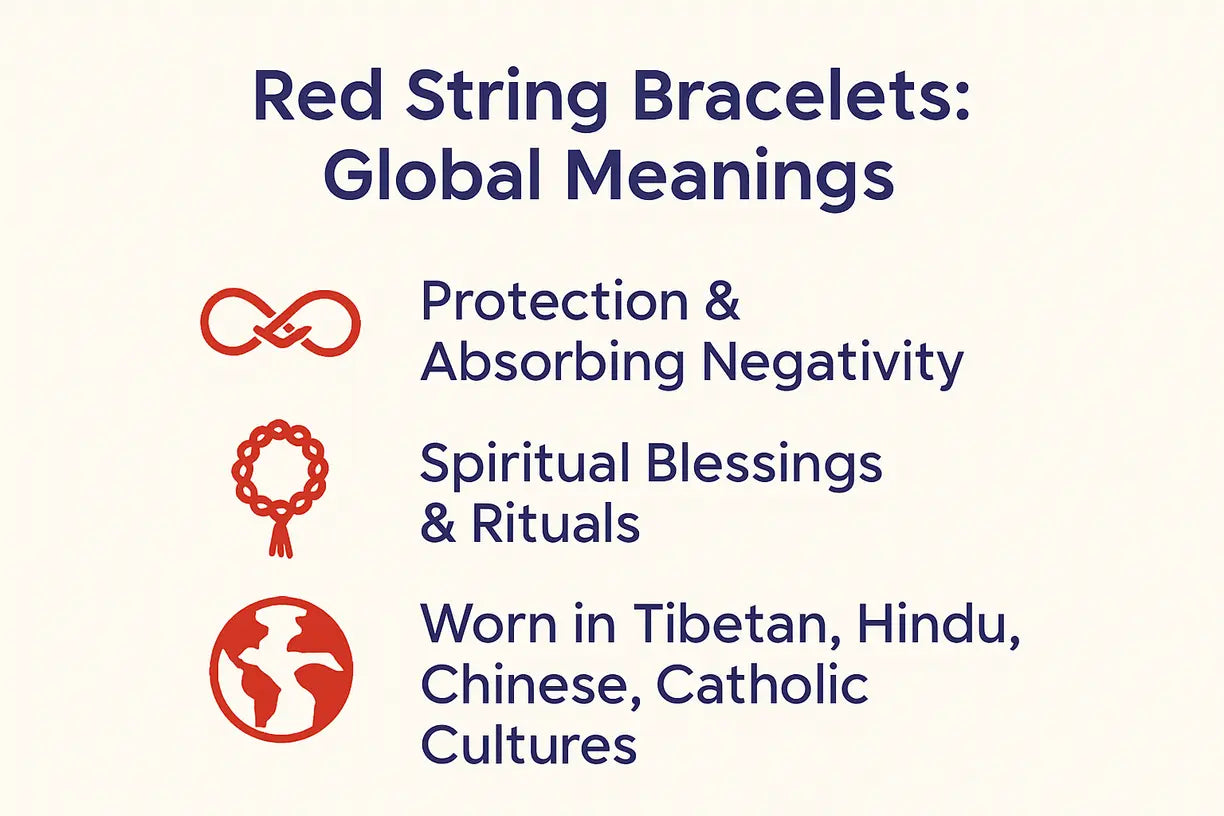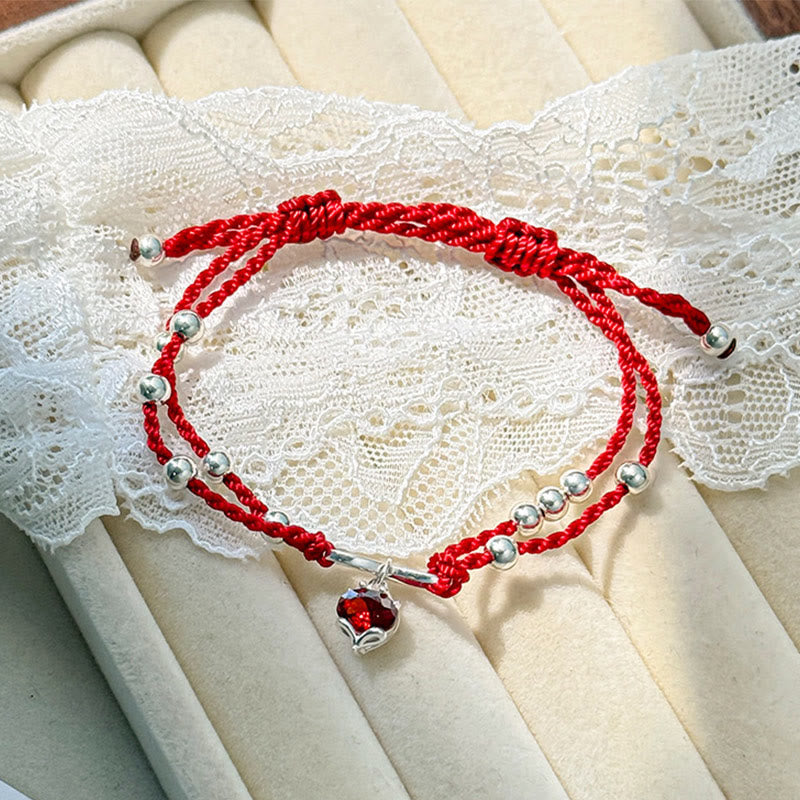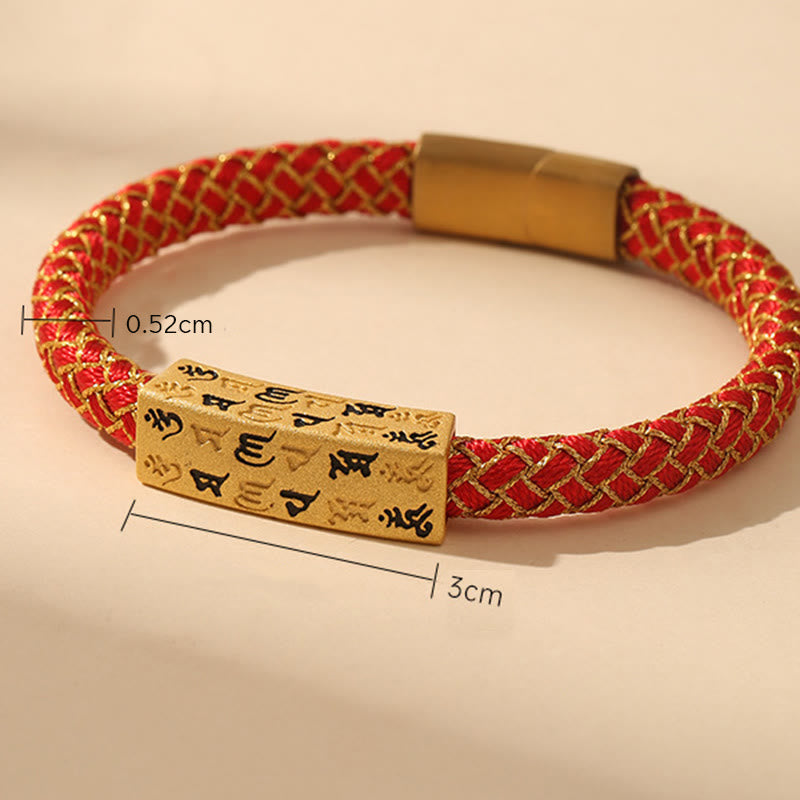Un simple fil rouge noué autour du poignet – une pratique courante dans les centres spirituels, les studios de yoga et les rues animées des villes du monde entier. Bien qu'apparenté à une tendance moderne, le bracelet tibétain en fil rouge est porteur d'une signification profonde et d'une importance culturelle séculaire. Plus qu'un simple accessoire, c'est un talisman de protection, un symbole de foi et un rappel de l'interdépendance qui transcende les frontières et les croyances.
Que vous soyez attiré par ses racines bouddhistes, son rôle dans les cérémonies hindoues ou son apparition dans la Kabbale, comprendre la riche mosaïque de traditions qui se cache derrière le fil rouge peut approfondir votre pratique spirituelle. Dans ce guide, nous explorerons le puissant symbolisme du bracelet en fil rouge dans les cultures du monde, des rituels sacrés des moines tibétains à sa signification dans les traditions chinoises, hindoues et même chrétiennes.
Le symbolisme fondamental : que représente le fil rouge ?
Dans de nombreuses cultures, la couleur rouge est un symbole puissant. Elle représente le sang et la force vitale, le feu et la passion, et est souvent associée au courage, à la chance et à la protection. Le bracelet en fil rouge canalise ces énergies universelles vers une intention unique et ciblée. Si les interprétations varient, trois thèmes principaux émergent : la protection, la connexion et l'intention spirituelle.
- Protection : Sa signification la plus courante est son pouvoir de conjurer le malheur et les énergies négatives. On pense souvent qu'il agit comme un bouclier contre le « mauvais œil », un regard malveillant censé causer du tort.
- Connexion : Dans des traditions comme le folklore chinois, un fil rouge relie les âmes destinées. Pour d’autres, il symbolise un lien avec un maître, une lignée spirituelle ou une communauté de foi.
- Intention : Porter un cordon rouge est souvent un acte de définition d’une intention personnelle : un engagement envers un chemin spirituel, un rappel d’un vœu ou une concentration sur un objectif ou une prière spécifique.

Le bracelet bouddhiste tibétain en fil rouge : une tradition sacrée
Dans le bouddhisme tibétain Vajrayana, le fil rouge est un objet profondément sacré. Ces bracelets sont souvent bénis par un lama ou un moine de haut rang lors d'une cérémonie. Ce rituel implique la récitation de mantras et de prières, imprégnant le fil d'une puissante énergie positive et d'intentions bienveillantes. Un bracelet en fil rouge béni par les moines n'est pas seulement décoratif ; il rappelle constamment les vœux bouddhistes prononcés ou les bénédictions reçues.
On le porte traditionnellement au poignet gauche . Selon les croyances ancestrales, le côté gauche du corps est le côté « réceptif », ce qui en fait le point idéal pour absorber les énergies protectrices et les bienfaits du bracelet dans l'âme. Recevoir le bracelet est un rituel de protection en soi, reliant celui qui le porte à la lignée et à la sagesse des enseignements bouddhistes.

Le fil rouge des pratiques spirituelles mondiales
Le pouvoir du fil rouge ne se limite pas au bouddhisme. Sa présence dans de nombreuses autres cultures souligne son attrait universel comme symbole de foi et de protection.

Dans l'hindouisme (Kalava)
Dans l'hindouisme, le cordon rouge est appelé « Kalava » ou « Mauli ». Il est noué au poignet par un prêtre lors des pujas (rituels de prière). Pour les hommes et les femmes célibataires, il est généralement noué au poignet droit, tandis que pour les femmes mariées, il est porté au poignet gauche. Le Kalava symbolise le lien avec Dieu et est censé apporter bénédictions, bonne fortune et protection contre le mal.
Dans la Kabbale et le Judaïsme
Cette pratique a acquis une grande popularité grâce à son association avec la Kabbale, une forme de mysticisme juif. Ici, un cordon de laine rouge est porté au poignet gauche pour éloigner le mauvais œil . Cette tradition est souvent associée au Tombeau de Rachel en Israël, où un cordon rouge était enroulé autour du tombeau de la matriarche avant d'être découpé en bracelets pour lui conférer son énergie protectrice et maternelle.
Dans la culture chinoise
Le bracelet chinois en fil rouge est intimement lié au concept du « fil rouge du destin ». Ce fil invisible serait noué autour des chevilles de ceux qui sont destinés à se rencontrer et à s'entraider. Dans le contexte amoureux, il relie les âmes sœurs. Porter un fil rouge peut attirer la chance en amour et honorer ces liens dus au destin.
Bracelet en fil rouge Fox Peach Blossom pour la connexion et la chance
$35.90 $51.90
Honorez la tradition tibétaine et chinoise du fil rouge avec ce bracelet de fleur de renard propice pour la chance et la connexion.
Explorer le produitDans le christianisme
Bien que moins courant, certains chrétiens portent également des cordons rouges. Cette pratique remonte souvent à la Bible hébraïque, où Rahab utilisait un cordon écarlate pour protéger sa famille. Pour eux, il peut être un symbole de foi, de rédemption et de protection divine.
Comment porter un bracelet en fil rouge et que se passe-t-il lorsqu'il se casse ?
Dans la plupart des traditions, le fil rouge doit être porté jusqu'à ce qu'il tombe tout seul. Il est courant de formuler un vœu ou une intention claire au moment de nouer le bracelet. Il est conseillé de le porter en permanence, même pendant le bain ou le sommeil, afin de préserver son champ énergétique.
Lorsqu'un bracelet finit par s'effilocher et se casser, ce n'est pas un signe de malchance. Au contraire, cela signifie qu'il a rempli sa fonction. Il a absorbé toute l'énergie négative qu'il pouvait contenir, ou que le vœu formulé en le portant s'est réalisé. À ce stade, vous pouvez simplement le remplacer par un nouveau, fixant ainsi une nouvelle intention pour le prochain chapitre de votre cheminement.
[curseur de collection]
Découvrez des outils de protection spirituelle
$24.90
$35.90
Adoptez la protection et l'abondance : cette pièce mélange le symbolisme de la ficelle rouge tibétaine, du cinabre et du bois de pêche. En savoir plus ➔
$28.90
$41.90
Découvrez la tradition bouddhiste authentique : un bracelet brodé de mantras pour une protection spirituelle et une inspiration quotidienne. En savoir plus ➔
Un symbole universel d'espoir et de connexion
Des montagnes himalayennes aux rues d'Hollywood, le bracelet en fil rouge témoigne avec force de notre désir commun de protection, de connexion et de chance. Que vous le portiez dans le cadre d'une tradition bouddhiste sacrée, comme emblème culturel ou comme rappel personnel d'une intention, ce simple fil vous relie à une mosaïque mondiale de foi et de spiritualité. Il nous rappelle que, quel que soit notre chemin, nous recherchons tous un peu plus de chance, d'amour et de protection.
Explorez notre collection de bracelets significatifs et trouvez celui qui parle à votre esprit et soutient vos intentions.
Questions fréquemment posées sur les bracelets à cordon rouge
Un bracelet tibétain rouge, surtout s'il est béni par un moine, est un symbole de protection contre les énergies négatives , le malheur et le mauvais œil. Il rappelle également les enseignements et les vœux bouddhistes, favorisant la compassion, la chance et la connexion spirituelle.
Porter un bracelet en fil rouge est une pratique interculturelle symbolisant protection, chance et foi. Sa signification spécifique varie selon les traditions : de la protection contre le mauvais œil dans la Kabbale à la représentation d'un lien sacré dans l'hindouisme, en passant par le symbole des liens du destin dans le folklore chinois.
Un bracelet tibétain en fil rouge se porte traditionnellement au poignet gauche . Dans de nombreuses traditions spirituelles, le côté gauche du corps est considéré comme le côté « réceptif », permettant ainsi à celui qui le porte d'absorber plus efficacement les énergies protectrices et les bienfaits du bracelet.
Pour porter un bracelet en fil rouge du Tibet, demandez à une personne de confiance de l'attacher à votre poignet gauche. Pendant le nouage, formulez une intention claire ou un vœu. Portez-le sans interruption jusqu'à ce qu'il tombe naturellement, signe qu'il a rempli sa fonction protectrice.
Dans différentes cultures, les bracelets en fil rouge sont portés principalement pour une protection spirituelle, pour attirer la chance et comme symbole de foi. Si les histoires et les rituels spécifiques diffèrent (par exemple, les bénédictions bouddhistes, les pujas hindoues, la tradition kabbaliste), la fonction première de ce puissant talisman repose sur une croyance universelle partagée.







